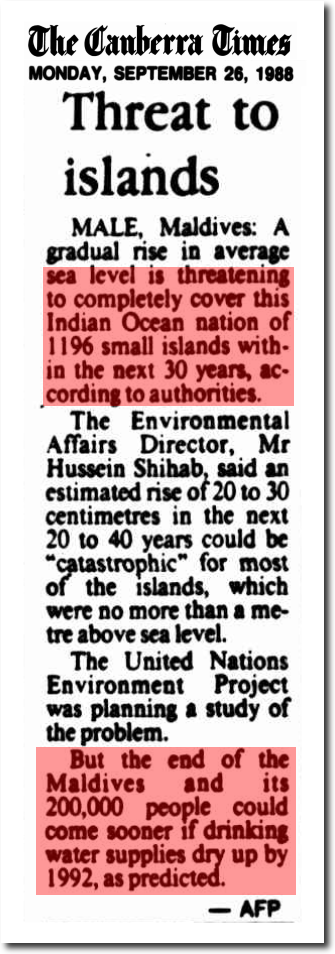You need to start reading your sources, friendo:
"That objective led a fieldwork team to the Maldives, and resulted in a conclusion that sea level in the islands fell by approximately 30 cm during the past few decades. In the present paper, the suggestion of such a fall has been examined from meteorological and oceanographic perspectives and found to be implausible."
"Without any real evidence for a hitherto-unrecognised process which could lead to a sea level change as significant as that proposed by the fieldwork team, one concludes that a rise in sea level of approximately half a metre during the 21st century, as suggested by the Intergovernmental Panel on Climate Change Third Assessment Report, remains the most reliable scenario to employ in future studies of the islands."
It is not saying "We found in our research that the sea level dropped 30cm", it is saying the exact opposite. That their research found that other assertions that sea level dropped 30cm were unfounded and that sea level rise in accordance with models was the most likely scenario.
Further data from the Maldives indicates that sea level rise is in fact occurring at a similar rate to the rest of the world:
"The results show that Maldives coastal sea level is rising in the same way (rising trend) as the global sea level. The mean tidal level at Male has shown an increasing trend of about 4.1 mm/year.Similarly at Gan, near the equator,it has registered a positive trend of about 3.9 mm/year."
https://www.tandfonline.com/doi/abs/10.1080/014904102753516787
" Results show that recent sea level trends in the Maldives coast are very high. At Male, the capital of the Republic of Maldives, the rising rates of Mean Tidal Level (MTL) are: 8.5, 7.6, and 5.8 mm/year during the postmonsoon (October-December), Premonsoon (March-May) and southwest monsoon (June-September) seasons respectively. At Gan, a station very close to the equator, the increasing rate of MTL is maximum during the period from June to September (which is 6.2 mm/year). "
https://www.tandfonline.com/doi/abs/10.1080/014904101753227851
That said, similar to Sweden and Finland as discussed earlier, there are other factors at work than just sea level. The land is also changing. Reef islands are able to change shape in response to shifting sediments. However, the impact of this is affected by the presence of human built structures which are not as fluid, so it is still important to have a plan for sea level change and it is important to do what is possible to reduce this sea level change.This may explain both why many urban areas such as the capital are seeing sea level rise, and why other areas are seeing sea level falling, again, without doing much to provide a counterpoint against the idea that global sea level is rising.
https://www.nationalgeographic.com/news/2015/02/150213-tuvalu-sopoaga-kench-kiribati-maldives-cyclone-marshall-islands/
Last edited by sundin13 - on 17 February 2020






















































